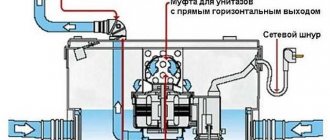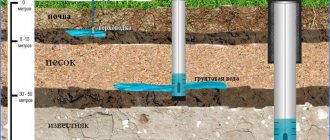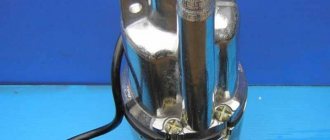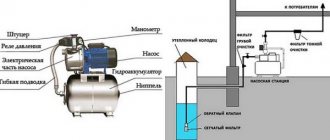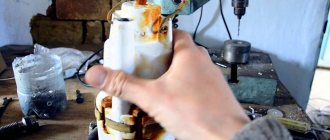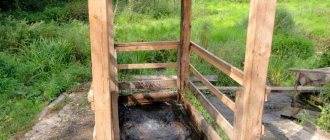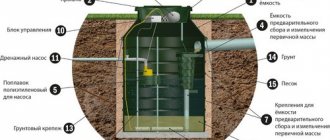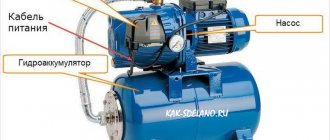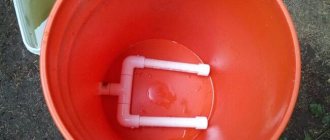Water, by itself, has no nutritional value. But at every step of his life, a person is certainly faced with its need.
For cooking, washing, heating and watering. There is nothing to replace water with. Unlike any other natural resources, it is vitally necessary for him.
Only a small amount is spent on cooking. The bulk is used for household and industrial needs. Including watering green spaces. A large number of different pumps are designed to facilitate this process, among which one of the main places is occupied by the Rucheyok vibration pump.
- 2 Types
- 3 Performance and technical specifications
- 4 Malfunctions and repairs
Basic faults
Most problems occur due to long service life or improper use of the device. The most common problems with the Brook, according to reviews from owners and repair specialists, include the following:
- When turned on, the pump starts to hum, but does not supply water.
- During operation of the device, extraneous noise can be clearly heard.
- Malfunction of the electrical part of the pump.
Thanks to the simplicity of the “Rucheyka” device, most of these problems can be resolved with your own hands.
Operating principle and device
Brook pump design.
(Click to enlarge) Since the eighties of the last century, the Brook pump has been manufactured in the Republic of Belarus by the Mogilev OJSC Olsa.
This submersible vibration unit has established itself as an undeniable competitor to any models of this class.
This achievement is explained by simple reasons:
- The dimensions and cylindrical shape are very convenient for placing the Brook in various places that are not suitable for other models:
- in wells;
- at the bottom of deep wells;
- in flooded pits of basements and garages;
- on the banks of reservoirs.
- Ease of operation:
- there is no need to add water before starting work;
- no lubrication of mechanisms required.
- Impressive water pressure:
- from 3 meters - without changing characteristics;
- from a 50-meter depth - 0.2 m3/hour.
- Durability related to:
- quality of workmanship;
- long-term development of the technological process;
- no bearings or moving parts.
- Minimum power consumption - 225 W/hour.
The principle of its operation is based on the vibration of a movable armature with a membrane under the action of an electromagnetic coil. The membrane, through a check valve, sucks a portion of water into the cavity of the mechanism and, during the reverse stroke, pushes it out through the outer fitting.
A Ø3/4″ hose is attached to the fitting for distributing water to consumers. The minimalism of the design makes it easy to unscrew 4 screws and clean the vibration mechanism from blockages.
Expert advice: to maintain the pump in working condition for a long time, it is better to draw water through an additional filter.
Otherwise, sand or silt particles may get under the check valve. The performance of the device will be temporarily impaired.
Pump disassembly
Disassembling the pump usually does not cause much difficulty.
After lifting the device from the well, you should blow out the outlet fitting, removing any remaining water from the pump. All mating parts of the device should be marked with a marker in order to set them in the exact position during assembly. Then we proceed to disassemble the case, holding it in a vice by the ledges near the screws. The screws holding the two halves of the housing together (4 pieces) should be loosened evenly. After removing the cover, the vibrator is removed from the housing - the main working unit of the pump.
By unscrewing the fixing washer located on top of the vibrator, you can disassemble the entire assembly. All components are strung on the central rod one after another, like the rings on a children's pyramid. The main thing is to remember the correct sequence of all these parts when disassembling the vibrator. To do this, it is recommended to capture each stage of dismantling with a phone camera.
Great capabilities of a small unit
Of course, a trickle deep-well pump will not solve any global problems such as water supply to a large house, because it has a power of 150 to 225 W on average. But it will help to cope with many problems.
Water supply to the house
At the dacha or in a private house, these units cope quite well with the water supply. True, the owners will not be able to take a bath, do laundry and wash dishes at the same time, because the seven liters per minute that the pump is capable of delivering is not enough for all these needs. But if you use it locally, in one place, then the pressure will be enough for both showering and washing. True, the pressure directly depends on the depth of the water resource. And the higher this number, the less power the serve will have.
It is not recommended to connect such pumps simultaneously to a house, bathhouse and other buildings, because this is too much work and can overload the system.
Using “Rucheek”, summer residents bring water into the house
On the right is a tap for connecting to hoses from the well, on the left is an outlet for a watering hose
Temporary replacement of the main pump
Some owners who use more powerful equipment in their home water supply purchase trickle water pumps as a backup. After all, any device can have breakdowns, and if the main unit suddenly breaks down, it will take more than one day until they find out the cause of the breakdown and take it for repair. And then a spare version of the pump will come in handy, which will not produce large volumes of water, but will be quite suitable for meeting basic needs.
Use in slow-filling springs
When digging a well or drilling a well, you can’t guess how quickly the water level can be restored after intensive use. One source will do this instantly, while the second will take hours to update. But when buying pumps, this factor is somehow forgotten, and there are situations when a powerful unit pumps out water faster than it can be replenished. In such a situation, having dried the source to the bottom, the system will automatically turn off and will have to be restarted. In addition, with rapid sampling, the likelihood of cloudiness increases. Therefore, for sources with a weak recovery level, it is better to use the Rucheek pump, whose intake intensity is lower, but it will work stably.
The trickle pump is suitable for wells with a pipe diameter of 100 mm
Restoring a clogged well
Some wells, when used intermittently, tend to become washed out, which reduces both the water level and the possibility of its rapid renewal during pumping. You can try to revive the system using the “Stream”. Of course, it will not change the quality of water, but it will increase the volume.
To do this, lower the pump as close to the filter as possible and turn it on. The vibrating mechanism will knock out solid deposits from the filter and then lift them to the surface. A couple of such attempts and the well will be in order.
By the way, during resuscitation there is no need to stand over the well. Due to the small throughput, water pumps will still not completely pump out the water. So at this time you can start watering the garden. At the same time, you will see whether the quality of the water and its volume are changing: the stream from the hose will become stronger and free of impurities.
Pumping water out of flooded premises
Spring floods often “delight” summer residents with flooded basements, cellars and inspection holes in garages. It is difficult to carry large volumes of water with buckets, but using a pump can remove it slowly but surely. Moreover, this procedure does not last one day. Drainage water is usually clean, so there will be no problems with pumping.
Filling a new heating system
When constructing private houses, the heating system is sometimes created before it is connected to the water supply. In this case, you need to somehow fill the pipes. They do this: they bring water in a barrel, insert a hose from the pump into it, and connect the second one to the drain valve of the batteries. Open the tap and start the unit. While the system is filling, look at the pressure gauge to determine when the pressure reaches the desired level.
Pump repair
Do-it-yourself repair of the trickle pump should be done if the warranty period has already expired. Each type of problem has its own causes. Consequently, the methods for eliminating them will also be individual.
When connected to the power grid, the “Rucheyok” hums, but does not pump water
Most likely, the reason is the depressurization of the housing. If the casing is narrow, the pump casing may hit it during operation. Considering the vibration speed reaching 100 per second, such impacts lead to peeling of the magnet filling.
The same phenomena are observed when the pump was running dry without water. The repair consists of removing the magnet from the vibrator. Next, using a grinder, small grooves are cut across its entire area. Afterwards, apply a layer of sealant to it and install it in its place. After the sealant has completely hardened, the device is assembled and tested for correct operation.
Extraneous noises, in the form of metallic jingles
You should disassemble the housing and inspect the device from the inside. When a black spot and an imprint from the armature are visible on the magnet, it is clear that they come into contact during operation. This may cause the motor winding to burn out. We measure the height of the fill with a caliper - it should be 4.9 cm.
If this height decreases during operation, you will need to place an adjusting washer or several washers of the required thickness into the bushing. After this, the pump is assembled and tested. If the washer is chosen exactly in size, then the metallic knock should disappear.
Electrical problems
The integrity of the motor winding can be checked with an ohmmeter. If the device reading is too high, a circuit break is possible, and if the resistance reading is zero, the motor winding is probably broken. Rewinding a motor is a complex and often unprofitable task.
It’s easier to buy a new engine, or even a new pump. If, when the pump is turned on, the safety circuit breakers (plugs) turn off, then there is a short circuit. You should check the integrity of the power cable, as well as other elements of the internal wiring.
If you are not confident in your qualifications as an electrician, it is better to hand over the “Rucheyok” to specialists for inspection and subsequent repairs. Electricity does not like amateurs, and a frivolous attitude towards it can lead to great trouble.
Kinds
Pump Rucheyok V-40
The simplicity of the design is reflected in the number of types of Rucheyok pumps, although the number of manufactured modifications is quite large.
This is due to the principle of drawing water from a reservoir (reservoir):
- model with upper position of the check valve (upper water inflow).
Rucheyok-V-10, V-15, V-25, V-40. The pump is constantly in the water and is not in danger of overheating;
- with lower valve position (lower water inflow).
Rucheyok-N-10, N-15, N-25, N-40. It is possible that the pump, having pumped out as much water as possible, ends up in the air, which threatens inevitable overheating. To avoid this, it is equipped with a thermal relay that protects it from overheating.
In terms of design and technical characteristics, both types of pumps differ little from each other. The numerical indicators for all modifications indicate the length of the supply cable - from 10 to 40 meters.
You may be interested in an article about the features of the Malysh vibration pump. Read an interesting article about the Aquarius vibration pump here.
A stream for all occasions
Small-volume wells can be equipped with a Rucheek pump. There is no need to purchase an expensive device for them, because... it will pump out fluid too quickly and dry running may occur. The operating instructions indicate that the device is used to supply drinking water. But consumers have found wider applications for the device. They use such a pump when pumping wells.
This pump is perfect for small wells.
A vibration unit can perform a large number of household functions. After drilling, the water contains a lot of sand; To clean it, install a pump. The water pump does not have rotating components and does not become clogged in dirty liquid. It is necessary to periodically remove the device from the well, wash it, and disassemble it. If malfunctions occur, the device is repaired and then immersed in water again.
Specifications
Each modification has its own technical characteristics. But there are common characteristics that are common to all models. These include:
- Power consumption. Each device needs from 220 to 300 W to operate.
- In order for the “Rucheek” pump to operate uninterruptedly, it needs a voltage of 220 V. In other words, you need a regular household electrical network.
- The maximum pressure, depending on the model, is from 40 to 60 m.
- Performance depends on depth. For example, if the liquid needs to be raised to a height of 1 m, then the pump can supply 1.5 cubic meters of water in an hour. From a depth of 40 m during the same time, the device will pump about 430 liters of liquid.
Based on the technical characteristics listed above, the Rucheyok pump is an ideal unit to meet the needs of any country house.
Below are also the technical characteristics of vibration-type equipment:
- The pump housing houses two working chambers. One of them is motor, the other is a pump with an anchor and a pump.
- The chambers are separated by a round diaphragm, made of thick elastic rubber. An anchor is attached to the rod, which is equipped with a rubber shock absorber.
- A magnetic coil is located in the chamber with the motor. It causes oscillations of the armature, which drives the pump pumping liquid.
- To ensure water drainage, the pumps have a valve. When the unit is turned on, it closes the hole, and when the device is turned off, the valve moves back and the liquid leaves the working area of the pump compartment without obstacles.
Specifications
Different modifications of pumps of this brand differ only in power and performance. The table shows the technical characteristics of the Rucheek pump.
As you can see, the spread of some indicators is quite large, which requires explanation:
- The performance of the pump depends on the depth from which it pumps water. When diving to a depth of 40 m, it will be about 400 l/h, from a 20-meter depth the productivity will increase to 900 l/h, and if the intake is carried out superficially, from an open source with a dive of up to 1.5 meters, it will increase to one and a half cubic meters.
- Another important characteristic about the Brooklet pump is pressure. 40m is the nominal pressure at which the device provides the specified performance. As the pressure increases to the maximum value (60m), it drops.
- Low power consumption, not exceeding 300 watts and comparable to the power consumed by a conventional computer, makes the device very economical and most suitable for working in sources with low flow rates. More powerful units will quickly empty it and turn off, stopping the water supply. And the Brook will work evenly, providing, albeit small (5-7 liters per minute), but continuous supply.
- Such pumps are intended only for pumping clean water with temperatures up to +35 degrees Celsius and a content of undissolved mechanical impurities of no more than 100 grams per cubic meter.

